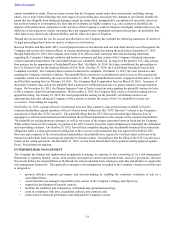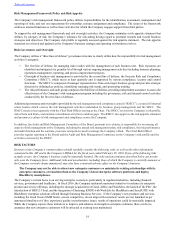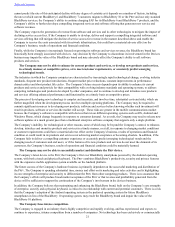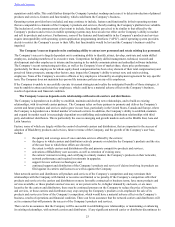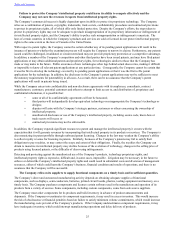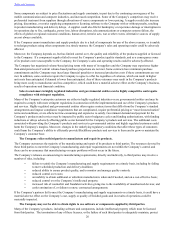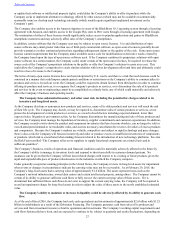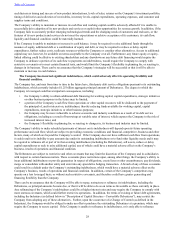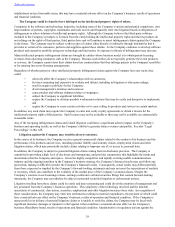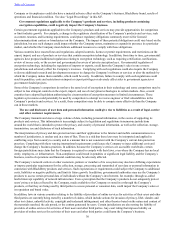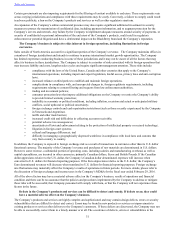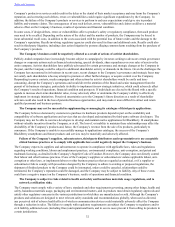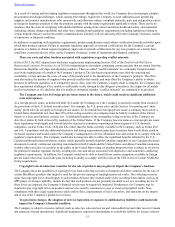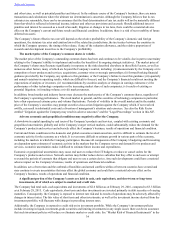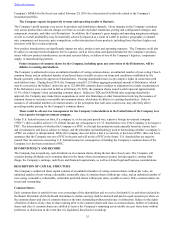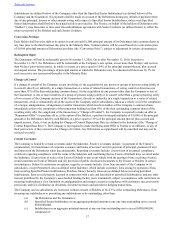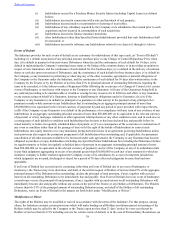Blackberry 2016 Annual Report Download - page 37
Download and view the complete annual report
Please find page 37 of the 2016 Blackberry annual report below. You can navigate through the pages in the report by either clicking on the pages listed below, or by using the keyword search tool below to find specific information within the annual report.
Table of Contents
28
such factors as timing and success of new product introductions, levels of sales, returns on the Company’s investment portfolio,
timing of deliveries and collection of receivables, inventory levels, capital expenditures, operating expenses, and customer and
supplier terms and conditions.
The Company’s ability to maintain or increase its cash flow and working capital could be adversely affected if it is unable to
successfully drive adoption of its new products and services or exploit other opportunities for revenue growth. In addition, if the
Company fails to accurately predict emerging technological trends and the changing needs of customers and end users, or the
features of its new products and services do not meet the expectations or achieve acceptance of its customers, its cash flow,
liquidity and financial condition could be materially harmed.
If the Company is unable to maintain or increase its cash balance, it may be required to raise additional funds through the
issuance of equity, additional debt or a combination of equity and debt, or may be required to reduce or delay capital
expenditures, further reduce costs, reallocate resources within the Company or consider other alternatives. Access to additional
capital may not, however, be available on terms acceptable to the Company or at all. Furthermore, any future equity or equity-
linked offering could be dilutive to existing shareholders and any drawdown on any future debt financing would require the
Company to dedicate a portion of its cash flow to payments on indebtedness, would require the Company to comply with
restrictive covenants or to meet certain financial tests, and would limit the Company’s flexibility in planning for, or reacting to,
changes in its business. There can be no assurance that the Company’s strategies will be successful or that it will be able to
maintain or increase its cash balance.
The Company has incurred significant indebtedness, which could adversely affect its operating flexibility and
financial condition.
The Company has, and may from time to time in the future have, third-party debt service obligations pursuant to its outstanding
indebtedness, which currently includes $1.25 billion aggregate principal amount of Debentures. The degree to which the
Company is leveraged could have important consequences, including:
• the Company’s ability to obtain additional debt financing for working capital, capital expenditures, strategic initiatives
or other business purposes in the future may be limited;
• a portion of the Company’s cash flow from operations or other capital resources will be dedicated to the payment of
the principal of, and/or interest on, indebtedness, thereby reducing funds available for working capital, capital
expenditures, strategic initiatives or other business purposes;
• the Company may be more vulnerable to adverse economic and industry conditions as a result of its debt service
obligations, including as a result of borrowings at variable rates of interest, which exposes the Company to the risk of
increased interest rates; and
• the Company’s flexibility in planning for, or reacting to changes in, its business and industry may be limited.
The Company’s ability to make scheduled payments of interest on its indebtedness will depend upon its future operating
performance and cash flow, which are subject to prevailing economic conditions and financial, competitive, business and other
factors, many of which are beyond the Company’s control. If the Company does not have sufficient cash flow from operations,
it could result in its inability to pay amounts due under its outstanding indebtedness or to fund other liquidity needs and it may
be required to refinance all or part of its then existing indebtedness (including the Debentures), sell assets, reduce or delay
capital expenditures or seek to raise additional capital, any of which could have a material adverse effect on the Company’s
business, results of operations and financial condition.
The Debentures are subject to restrictive and other covenants that may limit the discretion of the Company and its subsidiaries
with respect to certain business matters. These covenants place restrictions upon, among other things, the Company’s ability to
incur additional indebtedness or provide guarantees in respect of obligations, create liens or other encumbrances, pay dividends,
merge or consolidate with another entity and enter into any speculative hedging transaction. A breach of any of these covenants
could result in a default under the Company’s outstanding indebtedness, which would have a material adverse effect on the
Company’s business, results of operations and financial condition. In addition, certain of the Company’s competitors may
operate on a less leveraged basis, or without such restrictive covenants, and therefore could have greater generating and
financing flexibility than the Company.
There can be no assurance that the Company will be able to repay, restructure or refinance its indebtedness, including the
Debentures, as principal amounts become due, or that it will be able to do so on terms as favourable as those currently in place.
Any refinancing of the Company’s indebtedness could be at higher interest rates and may require the Company to comply with
more onerous covenants, which could further restrict its operations. In addition, the terms of existing or future debt agreements,
including the Indenture (as defined below in “Description of Capital Structure - Convertible Debentures”), may restrict the
Company from adopting any of these alternatives. Further, upon the occurrence of a Change of Control (as defined in the
Indenture), the Company would be obliged to make an offer to purchase the outstanding Debentures at a premium, which may
require the Company to secure capital. If the Company is unable to refinance its indebtedness, or is only able to refinance


